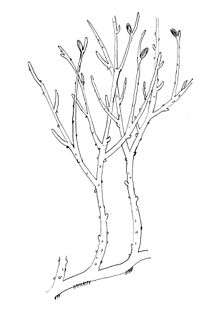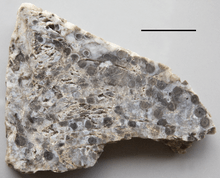Rhyniopsida
| Rhyniopsida Temporal range: Early Devonian[1] | |
|---|---|
 | |
| Reconstruction of Rhynia gwynne-vaughanii[1] | |
| Scientific classification | |
| Kingdom: | Plantae |
| Division: | Tracheophyta |
| Class: | †Rhyniopsida Kryshtofovich 1925 |
| Synonyms | |
| |
Rhyniopsida is a class of extinct early vascular plants, with one family, Rhyniaceae, found in the Early Devonian (around 419 to 393 million years ago). They are polysporangiophytes, since their sporophytes consisted of branched stems bearing sporangia (spore-forming organs). They lacked leaves or true roots but did have simple vascular tissue. The group was first placed in a subdivision of the division Tracheophyta under the name Rhyniophytina[2] (see Polysporangiophyte: Taxonomy for alternative names). Informally, they are often called rhyniophytes. More recently the name paratracheophytes has been suggested, to distinguish such plants from 'true' tracheophytes or eutracheophytes.[3]
As originally defined, the group was found not to be monophyletic since some of its members are now known to lack vascular tissue; these have been moved to the class Horneophytopsida, which is defined as lacking true vascular tissue. Currently, Rhyniopsida includes the genera Huvenia, Rhynia, and Stockmansella,[1] all from the Devonian.
One of the most important radiations for land plants occurred in the early Devonian (Pragian), when the first certain rhyniophytes appear in the fossil record,[1] making this rich fossil discovery of major importance to paleobotany. It has been suggested that the poorly preserved Eohostimella, found in deposits of Early Silurian age (Llandovery, around 440 to 430 million years ago), may be a rhyniophyte.[4]
Taxonomy
- Subphylum Rhyniophytina Banks 1968[5][6]
- Class Rhyniopsida Kryshtofovich 1925 [Rhyniidanae Jeffrey 1967]
- Order Rhyniales Němejc 1950
- Family Rhyniaceae Kidston & Lang 1920 [Sciadophytaceae Krausel 1938 nom. rej.]
- Genus ?Ambitisporites Hoffmeister 1959 [form taxa- spores]
- Genus ?Eocooksonia Doweld 2000
- Genus ?Sciadophyton Steinrnann 1930 non Steinmann 1929 [form taxa- gametophyte]
- Genus Huvenia Hass & Remy 1991
- Genus Rhynia Kidstson & Lang 1917 [Remyophyton Kerp Trewin & Hass 2004 form taxa- gametophyte stem]
- Genus Stockmansella Fairon-Demaret 1986 [Stockmansia Fairon-Demaret 1985 non; form taxa- axis]
- Family Rhyniaceae Kidston & Lang 1920 [Sciadophytaceae Krausel 1938 nom. rej.]
- Order Rhyniales Němejc 1950
- Class Rhyniopsida Kryshtofovich 1925 [Rhyniidanae Jeffrey 1967]
Phylogeny

In 2004, Crane et al. published a cladogram for the polysporangiophytes in which the Rhyniaceae are shown as the sister group of all other tracheophytes (vascular plants).[7] The other former "rhyniophytes", such as Horneophyton and Aglaophyton, are placed outside the tracheophyte clade, as they did not possess true vascular tissue (in particular did not have tracheids). However, both Horneophyton and Aglaophyton have been tentatively classified as tracheophytes in at least one recent cladistic analysis of Early Devonian land plants.[8]
Partial cladogram by Crane, Herendeen & Friis 2004[7] with emphasis on Rhyniophytes.
| polysporangiophytes |
| ||||||||||||||||||||||||||||||||||||
| |
(See the Polysporangiophyte article for the expanded cladogram.)
Rhynie flora
The general term "rhyniophytes" or "rhyniophytoids" is sometimes used for the assemblage of plants found in the Rhynie chert Lagerstätte - rich fossil beds in Aberdeenshire, Scotland, and roughly coeval sites with similar flora. Used in this way, these terms refer to a floristic assemblage of more or less related early land plants, not a taxon. Though the rhyniophytes are well represented, plants with simpler anatomy, like Aglaophyton, are also common; there are also more complex plants, like Asteroxylon, which has a very early form of leaves.
The Rhynie flora is unusual for the excellent preservation of early vascular plants, in addition to plants transitional between vascular and non-vascular. The fossils contain sufficient internal detail to determine vascular organization and to distinguish sporangia and gametangia. This has led to the recognition of species which apparently had an isomorphic alternation of generations (gametophytes and sporophytes of similar prominence), a condition unknown among land plants today. Because the plants were buried in situ, rather than after transport to a distant location, important morphological details and ecological information can be obtained. The site also preserves other organisms such as arthropods and fungi that lived in the Rhynie ecosystem.
See also
References
- 1 2 3 4 Kenrick, Paul & Crane, Peter R. (1997), The Origin and Early Diversification of Land Plants: A Cladistic Study, Washington, D.C.: Smithsonian Institution Press, ISBN 978-1-56098-730-7
- ↑ Banks, H.P. (1968), "The early history of land plants", in Drake, E.T., Evolution and Environment: A Symposium Presented on the Occasion of the 100th Anniversary of the Foundation of Peabody Museum of Natural History at Yale University, New Haven, Conn.: Yale University Press, pp. 73–107
- ↑ Gonez, P. & Gerrienne, P. (2010a), "A New Definition and a Lectotypification of the Genus Cooksonia Lang 1937", International Journal of Plant Sciences, 171 (2): 199–215, doi:10.1086/648988
- ↑ Niklas, K.J. (1979), "An Assessment of Chemical Features for the Classification of Plant Fossils", Taxon, 28 (5/6): 505, doi:10.2307/1219787
- ↑ Novíkov & Barabaš-Krasni (2015). "Modern plant systematics". Liga-Pres: 685. doi:10.13140/RG.2.1.4745.6164. ISBN 978-966-397-276-3.
- ↑ "Part 2- Plantae (starting with Chlorophycota)". Collection of genus-group names in a systematic arrangement. Retrieved 30 June 2016.
- 1 2 Crane, P.R.; Herendeen, P. & Friis, E.M. (2004), "Fossils and plant phylogeny", American Journal of Botany, 91 (10): 1683–99, doi:10.3732/ajb.91.10.1683, PMID 21652317, retrieved 2011-01-27
- ↑ Hao, Shougang; Xue, Jinzhuang (2013). The Early Devonian Posongchong Flora of Yunnan - A Contribution to an Understanding of the Evolution and Early Diversification of Vascular Plants. Beijing: Science Press. pp. 244–245. ISBN 978-7-03-036616-0.
External links
- http://www.palaeos.com/Plants/Rhyniophytes/index.html
- http://www2.ncsu.edu/unity/lockers/project/dendrology/index/plantae/vascular/vascular.html
- Cladogram from Crane, Herendeen & Friis 2004